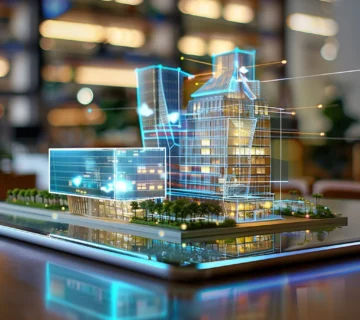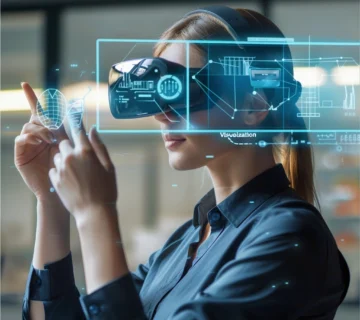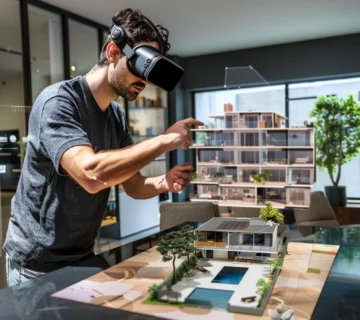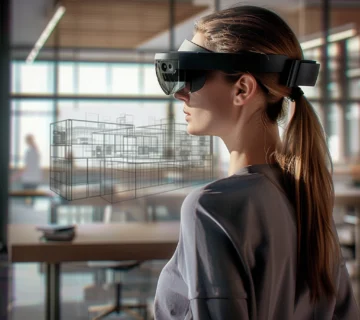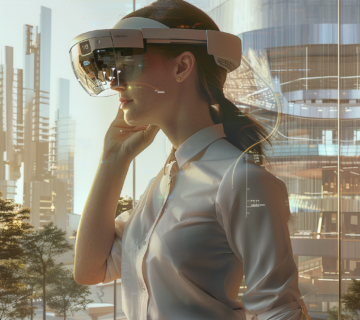Augmented Reality in Construction for Great Precision, Efficiency, and Innovation
Introduction:
In recent years, the construction industry has experienced a remarkable metamorphosis, primarily driven by groundbreaking technological advancements. One such transformative innovation that stands out is Augmented Reality (AR). Augmented Reality in Construction has emerged as a game-changer, revolutionizing traditional approaches to project execution. By seamlessly integrating digital information with the physical environment, AR empowers construction professionals with unprecedented levels of precision, efficiency, and innovation.
Through the strategic overlay of digital data onto real-world contexts, AR facilitates the visualization of intricate designs, facilitates error detection, and optimizes workflows to unprecedented degrees of accuracy and effectiveness. In this article, we embark on an exploration of the multifaceted benefits bestowed by Augmented Reality in Construction and delve into its profound implications for reshaping the future landscape of the industry.
Augmented Reality (AR) technology has rapidly gained traction in the construction sector, offering a transformative approach to project planning, design, and implementation. Unlike Virtual Reality (VR), which immerses users in entirely digital environments, AR enhances the real world by superimposing virtual elements onto physical spaces. In the realm of construction, this capability holds immense promise, as it enables stakeholders to visualize proposed structures within the context of existing surroundings. Architects, engineers, and contractors can now leverage AR-powered devices such as smartphones, tablets, or specialized glasses to overlay 3D models, construction plans, and other digital assets onto construction sites.
One of the key advantages of Augmented Reality in Construction lies in its ability to enhance visualization. By overlaying digital models onto real-world environments, AR enables stakeholders to gain a comprehensive understanding of spatial relationships, scale, and design aesthetics. This visual clarity facilitates informed decision-making and fosters collaboration among project teams. Moreover, AR facilitates real-time design modifications and iterations, as stakeholders can instantly visualize proposed changes within the context of the physical environment.
Furthermore, Augmented Reality in Construction significantly improves accuracy and efficiency throughout the project lifecycle. Construction professionals can use AR-enabled devices to precisely position structural elements, verify alignment with design specifications, and detect potential errors before they escalate into costly rework. This not only minimizes project delays but also enhances the overall quality of construction outcomes. Additionally, AR streamlines communication and collaboration among dispersed project teams by providing a shared digital platform for sharing information, annotating design revisions, and resolving issues in real-time.
Moreover, Augmented Reality in Construction holds immense potential for enhancing safety and risk mitigation efforts. By overlaying safety information, hazard warnings, and procedural instructions directly onto workers’ field of view, AR improves situational awareness and reduces the likelihood of accidents on construction sites. Furthermore, AR-based training simulations enable workers to practice hazardous tasks in a controlled virtual environment, thereby minimizing exposure to real-world risks.
In conclusion, Augmented Reality in Construction represents a paradigm shift in the way construction projects are planned, executed, and managed. By harnessing the power of AR technology, construction professionals can achieve unparalleled levels of precision, efficiency, and innovation throughout the project lifecycle. As AR continues to evolve and become more accessible, its transformative impact on the construction industry will only continue to grow, driving greater productivity, safety, and sustainability across construction projects worldwide.
Top of Form
Augmented Reality Revolutionizing Visualization and Collaboration in Construction
In the realm of construction, Augmented Reality stands out as a transformative tool, revolutionizing the way construction projects are conceived and executed. Augmented Reality technology provides construction teams with advanced visualization capabilities that go beyond the limitations of traditional design and planning processes. By seamlessly integrating digital 3D models of structures into real-world environments, Augmented Reality empowers stakeholders to immerse themselves in proposed designs with unparalleled depth and clarity.
This immersive experience allows architects, engineers, contractors, and clients to gain a comprehensive understanding of the proposed project within the context of its intended physical environment. Augmented Reality transcends the boundaries of traditional two-dimensional drawings and static models, offering dynamic and interactive visualizations that facilitate informed decision-making and enhance collaboration among project stakeholders.
Architects and engineers, armed with AR-enabled devices such as smartphones or tablets, can navigate through virtual models of buildings and infrastructure, gaining invaluable insights into spatial relationships, scale, and aesthetic considerations. This immersive experience allows professionals to assess design elements from various perspectives, identifying potential flaws or inefficiencies that may not be apparent through conventional 2D drawings or computer-aided design (CAD) models.
Moreover, Augmented Reality in Construction facilitates collaborative design reviews, as stakeholders can interact with virtual models in real-time, regardless of their physical location. Whether it’s discussing design iterations with clients or coordinating with subcontractors and suppliers, AR fosters seamless communication and collaboration by providing a shared digital platform where all parties can visualize and evaluate design proposals together.
Furthermore, the use of Augmented Reality in Construction enhances client engagement and satisfaction by offering clients a realistic preview of proposed designs within the context of their intended environment. Clients can walk through virtual representations of their future buildings, experiencing firsthand how different design choices may impact the look and feel of the space. This interactive approach not only builds trust and confidence in the design process but also empowers clients to make informed decisions that align with their vision and objectives.
From a practical standpoint, Augmented Reality in Construction significantly streamlines the design iteration process, enabling architects and engineers to identify and address potential issues early on. By spotting design flaws or clashes in virtual models before construction commences, project teams can avoid costly rework and delays during the construction phase. This proactive approach not only improves design accuracy but also enhances project efficiency and cost-effectiveness.
In essence, Augmented Reality in Construction represents a paradigm shift in how design and planning are approached in the construction industry. By leveraging AR technology to superimpose digital models onto real-world environments, construction professionals can achieve unprecedented levels of visualization, collaboration, and efficiency. As the adoption of AR continues to grow, it is poised to become an indispensable tool for driving innovation and excellence in construction projects of all scales and complexities.
Augmented Reality: Enhancing Precision and Efficiency in Construction Projects
In the realm of construction, where precision stands as a cornerstone of success, Augmented Reality (AR) in Construction emerges as a transformative force, reshaping the very fabric of project execution. Augmented Reality technology equips construction professionals with indispensable tools, enabling them to attain unrivaled levels of accuracy across diverse stages of construction endeavors.
Through the utilization of AR-enabled devices such as smartphones or tablets, fortified with cutting-edge spatial mapping and tracking capabilities, construction teams seamlessly integrate digital blueprints into the physical environment. This seamless amalgamation facilitates the meticulous placement of structural elements in accordance with pre-established design specifications, thereby minimizing inaccuracies and ensuring seamless alignment with the intended construction plans.
Augmented Reality in Construction serves as a potent safeguard against misalignments or discrepancies between digital designs and their physical counterparts. Empowered by AR, construction personnel overlay digital blueprints onto the construction site, affording them unparalleled visualization of structural placements, including beams, columns, and intricate piping systems, with unparalleled precision and clarity.
Furthermore, Augmented Reality empowers construction teams to tackle complex tasks with unwavering confidence and efficiency. Whether it entails laying foundations, erecting steel structures, or installing intricate machinery, AR technology furnishes real-time guidance and feedback, enabling workers to navigate through intricate construction processes with meticulous precision and streamlined ease.
Moreover, Augmented Reality in Construction elevates quality assurance to unprecedented levels by enabling construction professionals to swiftly detect and address potential issues or deviations from design specifications in real-time. Through the deployment of AR-enabled visualization tools, workers adeptly identify inconsistencies or clashes between digital models and physical structures, facilitating prompt corrective actions to preempt costly rework or project delays.
In summation, Augmented Reality in Construction emerges as a catalytic force, driving unparalleled precision and efficiency across construction projects. By seamlessly integrating digital insights with the physical realm, AR technology empowers construction teams to operate with heightened accuracy and confidence, thereby fostering the realization of superior construction outcomes and ensuring the attainment of overarching project success.
Augmented Reality: Advancing Safety and Risk Mitigation in Construction
Safety stands as a paramount concern within the construction industry, and Augmented Reality in Construction emerges as a formidable ally in bolstering on-site safety protocols and mitigating risks. Augmented Reality (AR) systems serve as invaluable tools, capable of overlaying critical safety information directly onto workers’ field of view, thereby significantly enhancing situational awareness and fostering a safer working environment.
By leveraging AR technology, construction personnel are equipped with real-time access to vital safety data, including hazard zones, evacuation routes, and equipment operating instructions. This augmented display of information serves as a constant reminder to workers, ensuring that they remain cognizant of potential risks and adhere to established safety protocols at all times. Such real-time guidance effectively reduces the likelihood of accidents and ensures compliance with stringent safety regulations governing construction sites.
Furthermore, Augmented Reality in Construction facilitates immersive training experiences through AR-based simulations, enabling workers to practice hazardous tasks within a controlled virtual environment. These simulations offer a safe and effective means of preparing workers for real-world scenarios, allowing them to familiarize themselves with proper safety procedures and protocols without exposing themselves to actual danger. By providing hands-on training opportunities in a risk-free setting, AR-based simulations empower construction workers to develop the skills and confidence necessary to navigate hazardous situations safely and effectively.
In essence, Augmented Reality in Construction serves as a pivotal tool in fostering a culture of safety and risk mitigation within the construction industry. By integrating AR technology into safety protocols, construction companies can enhance situational awareness, reduce the occurrence of accidents, and ensure compliance with regulatory standards. Moreover, the use of AR-based training simulations enables workers to hone their skills and proficiency in handling hazardous tasks, ultimately contributing to a safer and more secure working environment for all stakeholders involved in construction projects.
Augmented Reality: Transforming Collaboration and Communication in Construction Projects
Effective collaboration and communication stand as linchpins for the successful execution of construction projects, and Augmented Reality in Construction emerges as a catalyst for fostering seamless interaction among project stakeholders. Augmented Reality (AR) technology revolutionizes traditional communication channels by providing a common digital platform that overlays onto the physical environment, transcending geographical barriers and facilitating real-time collaboration.
Through the utilization of Augmented Reality in Construction, architects, engineers, contractors, and clients gain access to a shared virtual workspace that superimposes digital design elements and project data onto the construction site. This shared digital environment serves as a focal point for collaborative efforts, enabling stakeholders to visualize and interact with project information regardless of their physical location. Architects can showcase proposed designs, engineers can provide technical insights, contractors can offer practical feedback, and clients can provide valuable input, all within the context of the project’s physical surroundings. Augmented Reality in Construction thus serves as a transformative tool, breaking down geographical barriers and fostering seamless collaboration among project stakeholders.
AR-powered communication tools further enhance collaboration by enabling instant sharing of design revisions, progress updates, and feedback among project stakeholders. Whether it’s annotating design elements, highlighting areas of concern, or proposing modifications, augmented reality definition, facilitates seamless communication and decision-making in real-time. This streamlined communication process fosters greater transparency and efficiency throughout the project lifecycle, ensuring that all stakeholders are aligned with project objectives and timelines.
Moreover, Augmented Reality in Construction promotes proactive problem-solving and conflict resolution by providing stakeholders with a comprehensive view of the project’s status and challenges. AR technology allows for the overlay of digital information onto physical structures, enabling stakeholders to identify potential issues and address them before they escalate into costly delays or disputes. By fostering a collaborative environment where information is readily accessible and shared, AR in Construction empowers project teams to navigate challenges effectively and drive project success.
In conclusion, Augmented Reality in Construction redefines collaboration and communication in the construction industry, transcending traditional boundaries and fostering greater transparency, efficiency, and innovation. By providing a shared digital platform overlaid onto the physical environment, AR technology facilitates real-time interaction among project stakeholders, enabling seamless collaboration regardless of geographical locations. Through instant sharing of design revisions, progress updates, and feedback, for example augmented reality architectural visualization-powered communication tools enhance transparency and decision-making throughout the project lifecycle, ultimately driving greater project success and stakeholder satisfaction.
Augmented reality in construction Innovation and Sustainability
Augmented Reality in Construction is not merely a technological tool; it is a catalyst for innovation that is reshaping the very foundations of how the construction industry operates. This revolutionary technology empowers architects and engineers to explore uncharted territories of creativity and efficiency by providing a virtual sandbox where they can experiment with different design concepts and construction methodologies.
Imagine an architect being able to walk through a virtual representation of a building they’ve designed, not just as a static model on a computer screen, but as a fully immersive experience where they can interact with the space in real-time. Augmented Reality allows for this level of engagement, enabling stakeholders to visualize and analyze every aspect of a project before it even breaks ground. This level of foresight empowers teams to identify potential challenges, optimize resource utilization, and minimize waste from the earliest stages of a project.
Moreover, Augmented Reality in Construction extends its impact beyond the design phase, revolutionizing how buildings are maintained and managed throughout their lifecycle. By overlaying digital information onto physical structures, AR-enabled maintenance systems provide real-time insights into building performance metrics, allowing for proactive maintenance and energy efficiency optimization. This proactive approach not only extends the lifespan of buildings but also reduces operational costs and minimizes environmental impact.
Augmented Reality in Construction serves as a transformative force, transcending geographical barriers and fostering unprecedented collaboration among project stakeholders. By harnessing AR-powered platforms, architects, engineers, contractors, and clients are brought together in a virtual workspace where ideas flow freely and expertise is readily shared. This seamless exchange of knowledge and insights leads to the co-creation of sustainable solutions that tackle the multifaceted challenges confronting the construction industry. Augmented Reality breaks down traditional silos, empowering stakeholders to collaborate in real-time, regardless of their physical locations. Through this innovative approach, AR marketing campaigns not only enhances communication and collaboration but also fosters a culture of innovation where ideas flourish and transformative solutions emerge.
In essence, Augmented Reality in Construction represents a convergence of technology, creativity, and sustainability. It empowers stakeholders to push the boundaries of what’s possible, driving innovation and positive change within the construction industry. As the adoption of AR technology solutions continues to grow, its transformative impact on building design, construction methodologies, and sustainability practices will only continue to expand, ushering in a future where buildings are not just structures, but living, breathing entities that contribute to a more sustainable and resilient built environment.
In conclusion, Augmented Reality in Construction represents a monumental shift in the way the industry operates, fundamentally altering traditional approaches to project planning, execution, and management. This revolutionary technology serves as a catalyst for unparalleled precision, efficiency, and innovation throughout the entire project lifecycle. By seamlessly integrating digital information with the physical environment, AR technology solutions empowers construction professionals to visualize designs with unprecedented clarity, detect errors before they escalate, and streamline workflows to achieve optimal results.
Furthermore, Augmented Reality in Construction plays a pivotal role in enhancing safety measures on construction sites. AR systems overlay critical safety information, such as hazard zones and evacuation routes, directly onto workers’ field of view, thereby enhancing situational awareness and reducing the likelihood of accidents. Moreover, AR-based training simulations provide workers with hands-on experience in hazardous tasks within a virtual environment, minimizing exposure to real-world risks and ensuring preparedness for any eventuality.
Moreover, Augmented Reality facilitates seamless collaboration and communication among project stakeholders, transcending geographical limitations. Through AR-powered platforms, architects, engineers, contractors, and clients can collaborate in real-time, regardless of their physical location. This fosters greater transparency, efficiency, and innovation, leading to the co-creation of sustainable solutions that address the complex challenges facing the construction industry.
Augmented Reality in Construction extends its impact beyond the design phase, revolutionizing maintenance and facility management practices. AR visualization tools-enabled maintenance systems provide real-time insights into building performance metrics, allowing for proactive maintenance and energy efficiency optimization. This proactive approach not only extends the lifespan of buildings but also reduces operational costs and minimizes environmental impact.
Furthermore, AR development services empowers architects and engineers to explore new frontiers of creativity and efficiency. By providing a virtual sandbox where they can experiment with different design concepts and construction methodologies, AR unleashes untapped potential in building design and construction. This level of foresight empowers teams to identify potential challenges, optimize resource utilization, and minimize waste from the earliest stages of a project.
In essence, Augmented Reality in Construction signifies more than just the adoption of a new technology—it represents a fundamental shift in the way construction projects ,Exterior & interior visualizing in AR, are conceived, executed, and maintained. As AR technology continues to evolve and become more accessible, its transformative impact on the construction industry will only continue to expand, driving greater efficiency, sustainability, and value for stakeholders worldwide. Embracing augmented reality is not just about adopting a new tool—it’s about embracing a new way of building for a brighter, more efficient future.


“The shift towards augmented reality in construction: AR fosters enhanced communication by providing stakeholders with a shared platform where they can interact with 3D models, review plans, and identify potential issues in real time. Achieved this way seamless collaboration leads to reduced misunderstandings, quicker decision-making, and a more holistic approach to problem-solving.”[nsflow]




